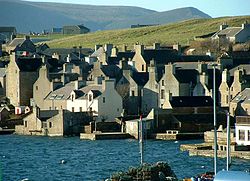Stromness
| Stromness | |
| Orkney | |
|---|---|
 Stromness from the harbour | |
| Location | |
| Island: | Mainland |
| Grid reference: | HY2509 |
| Location: | 58°57’36"N, 3°18’-0"W |
| Data | |
| Population: | 2,200 (approx.) |
| Post town: | Stromness |
| Postcode: | KW16 |
| Dialling code: | 01856 |
| Local Government | |
| Council: | Orkney Islands |
| Parliamentary constituency: |
Orkney and Shetland |
Stromness is the largest town in Orkney after Kirkwall. It stands in the south-west of Mainland where Scapa Flow opens to the Atlantic Ocean in Hoy Sound.
Stromness is Orkney's main ferry port, serving ships from Scrabster (Caithness), from Aberdeen and from Shetland, enjoying a sheltered harbour. Ferries also run to Hoy (barely a mile and a half across the Hoy Sound from the Ness) and to Graemsay, the island which lies in the middle of the Sound.
Contents
The town
The main street, Victoria Street and John Street, winds through Stromness above the harbour, the old town clustered along it. The delightful variety of shops and houses along the street, built of local stone give the town much of its friendly character. Running off the main street are narrow lanes and snickets reaching up to the higher roads.
The ferry port is a more practical aspect of the town, though kept to the shoreline and not as inhuman in scale as a major commercial port.
Churches
- Church of Scotland
- Orkney Christian Fellowship
- Scottish Episcopal Church: St Mary the Virgin
- Baptist: Stromness Baptist Church
Sights in and around the town
- Breckness House, erected in 1633 by the last bishop of Orkney, at the west entrance of Hoy Sound
- an ancient cemetery, with ruined church, and remains of a monastery between Breckness House and Stromness town.
Etymology
The name "Stromness" is derived from the Old Norse language; "Strom" refers to the strong tides that rip past the Point of Ness to the south of the town and "Ness" means "headland". Stromness. In Viking times Stromness was called Hamnavoe, meaning "peaceful" or "safe harbour".
History
First recorded as the site of an inn in the 16th century, Stromness became important during the late 17th century, when England was at war with France and shipping was forced to avoid the English Channel.
In later years, ships of the Hudson's Bay Company were regular visitors, as were whaling fleets. Stromness served asboth the last watering station before the Arctic seas but also as a rich recruitment ground for hardy sailors. Large numbers of Orkneymen, notably from Stromness, served as traders, explorers and seamen for both. The discoverer of the North West Passage, John Rae, was a Stromness man recruited as a company doctor by a visiting Hudson's Bay Company ship.
Stromness Museum reflects these aspects of the town's history (displaying for example important collections of whaling relics, and Eskimo artefacts brought back as souvenirs by local men from Greenland and the Hudson's Bay territories). This history explains an odd aspect to the town; the large number of buildings decorated with displays of whale bones outside them.
Miscellaneous
Sir Peter Maxwell Davies, who lives on Orkney, wrote a popular piano piece Farewell to Stromness. It was originally a piano interlude from 'The Yellow Cake Revue, a piece written to protest plans to open a uranium mine in the area. The Revue was first performed by the composer at the Stromness Hotel on 21 June 1980 as part of the St Magnus Festival and the uranium mine was cancelled later that year.
Stromness has given its name to a settlement, Stromness on South Georgia.
Parish
The parish of Stromness includes a tract of about 5 miles by 3¾ on Mainland and the whole of the Island of Hoy.
References
- The section on the parish and its geology incorporates text from the following out-of-copyright book: Wilson, Rev. John The Gazetteer of Scotland (Edinburgh, 1882) Published by W. & A.K. Johnstone
